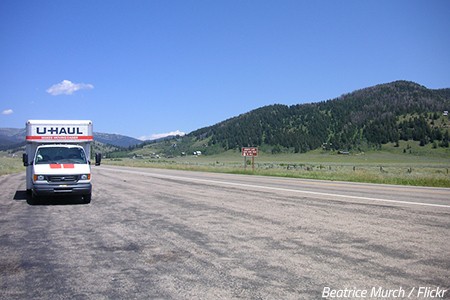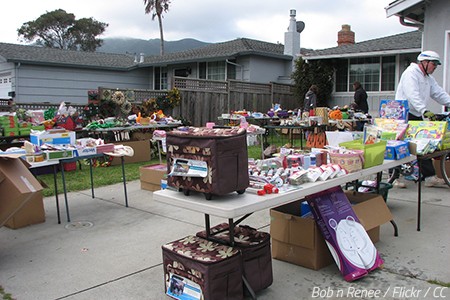 Under specific circumstances, organizing a DIY move could prove to be a good option for you.
Under specific circumstances, organizing a DIY move could prove to be a good option for you.
Basically, a self-move means that you’ll have to pack up all your household items by yourself, rent a moving truck from a reputable truck rental company, drive the van across the country until you reach the new home, and then return the moving vehicle to the company before you head to your new place to start unpacking.
Of course, a Do-It-Yourself move includes many additional tasks you should complete along the way, but these are the main steps during the house moving process.
It’s important to note that driving a moving truck cross country is not easy at all, and if you’ve never driven a large van before, the task before you may prove to be more than you can handle safely.
However, if you have previous driving experience behind the steering wheel of a large truck, then you just may be able to pull it off without any major problems or accidents on the road.
To help you accomplish that feat, here are the top 12 tips for driving a moving truck across the country.
1. Get familiar with the rental truck
Hopefully, you will have contacted a reputable truck rental company and selected a moving van of the right size. Needless to say, it’s critical that you pick a moving truck with the correct cargo capacity – if not, then you’re likely to deal with a number of problems – from paying for extra space that you never use to having to complete several trips to the new place or even being forced to leave behind some of your stuff.
Below you’ll find 10 great tips for renting a moving truck that will help you avoid any headaches during the truck rental process.
Now, your very first task after you have rented the right moving van for your specific needs is to familiarize yourself with the vehicle. Learn how the basic controls work, including how to operate the turn signals and the windshield wipers.
Adjust the side-view mirrors, adjust the driver’s seat if necessary, learn how to switch on and off the exterior lights, and check the parking brake.
In most cases, all basic controls of the moving truck should be self-explanatory or at least pretty logical. If you have any questions, turn to the truck rental agency for assistance.
10 Tips for Renting a Moving Truck for Your DIY Move
2. Load the truck correctly
It’s important to know that your items have been loaded properly in the back of the truck before driving off.
In fact, there are two major reasons why you should make sure your things are arranged well in the cargo area of the moving vehicle and that they as secure as they can be:
- Sharp turns or sudden braking can cause your household items to shift in the back of the truck unless you have secured them well using ratchet straps or proper arrangement. Stacked boxes or large furniture pieces that have not been secured well can topple over, resulting in costly damage.
- If the load in the back of the van is not well balanced – that is, most of or all heavy items have been loaded only on one side, then the moving vehicle will be much harder to handle. What’s more, improper loading of the rental truck could result in a road accident – the very last thing you’d ever want during your house move.
3. Increase the speed gradually
One thing that you’ll notice right away when driving a moving truck cross country is that the vehicle will most likely feel a bit sluggish compared to your own passenger car. And that’s normal – the sense of sluggishness will be a direct result of the large size of the rental truck and its increased mass due to the extra load.
So, when driving a rental truck across the country, remember to increase the speed gradually. Whenever possible, avoid any sudden acceleration because it can often lead to increased fuel consumption and possible shifts of the items loaded in the back.
Some rental trucks may be limited electronically to a pre-set safety speed (75 mph in most cases), so it’s a good idea to ask the truck rental company beforehand if that’s the case of the vehicle you’ve hired.
12 Brilliant Packing Tips and Tricks for Moving
4. Brake early and lightly

Driving a moving truck is similar to driving a passenger car… but it does have its peculiarities.
Sudden acceleration when driving a moving truck is not recommended. However, sudden braking can be even worse since the created braking force will cause the truck load to shift forward, thus creating the possibility of great damage to your possessions.
When driving a large moving truck, avoid braking too suddenly and too hard unless you have to do it to avoid a road accident. The real danger of slamming on the brakes while driving a rental truck cross country is that there’s always a chance that the big and heavy vehicle gets thrown off-balance. And if that happens, then you could potentially lose control of the van.
When driving a rental truck in bad weather – rain, snow, ice, strong side winds, then you must never apply the brakes suddenly. Instead, brake early when approaching intersections and do it softly to kill the speed gradually.
5. Drive at a safe distance from other vehicles
When you’re used to driving a passenger car, you know the safe trailing distance you should keep from the vehicle in front of you. As a rule of thumb, you should follow the 2-second rule when driving a passenger car. The 2-second rule states that, under ideal conditions, a driver should stay at least 2 seconds behind any vehicle that is directly in front of their vehicle.
Now, when driving a fully-loaded rental truck, you should give yourself an additional buffer of 2 seconds. Therefore, when driving a large moving truck that’s fully loaded with your possessions, make sure you follow the 4-second rule to improve road safety and minimize the risk of collision.
Be mindful that when driving a moving truck in adverse weather conditions – rain, snow, or ice – you have to increase the trailing distance even more.
Hire Movers or Move by Yourself? What Should You Do?
6. Refrain from overtaking other vehicles
Depending on the size of the truck you have rented, you may have to refrain from overtaking other vehicles when driving uphill or when navigating through narrow roads. The bigger the truck, the more time and distance it will require to overtake another vehicle on the road.
Of course, sometimes you will have to overtake other vehicles, especially when you’re stuck behind one that’s even slower than you are. Driving on the far right lane on the highway will help you minimize the number of overtaking maneuvers.
Still, when you just have to do it, then you have to do it.
Check the rear-view mirrors for any fast-approaching vehicle, and when there are none, step on the gas pedal and complete the overtaking move as quickly as possible.
The important thing you should remember here is that the rental van is not a sports car, so you should never treat it like one.
7. Make turns wider, much wider
Seriously though, how hard is it to drive a rental truck? The answer to this very question depends on how much experience you have in driving vehicles that are larger than a passenger car.
Simple maneuvers like turning may prove to be trickier than you think when you’re driving a rental truck across state lines. The thing is that most moving trucks will require much more space than standard passenger cars to make a turn, especially when it’s a right turn.
Whenever you need to make a turn with the rental van, reduce the speed substantially or even consider stopping the vehicle completely when you’re about to make a sharp turn, be it a right one or a left one.
Remember to always make turns wider than you’re used to making them so that you don’t hit a curb or worse – hit another vehicle during the maneuver.
Top 10 Tips for Saving Money on a Long-Distance Move
8. Be extra careful when backing up

Backing up with a rental truck can be trickier than you think.
One of the first things you’ll notice when you rent a moving vehicle is that, unlike a passenger car, it doesn’t have a center rear-view mirror – the one situated above the middle section of the dashboard. As a result, you can only rely on side-view mirrors when driving the rental truck to a new state or driving it within the same state until you reach the destination home.
Without a rear-view mirror, it can feel a bit awkward when you’re trying to change lanes, when making turns, or when driving in reverse.
One of the best pieces of advice when driving a moving truck to a new home is to avoid backing up the vehicle, whenever possible. When you have to park the van, look for parking lots that you can exit while driving forward, without having to go in reverse. Also, try to avoid parking the truck in tight spaces that will force you to back up the vehicle when it’s time to continue your house moving journey.
9. Stay alert when parking the truck
You might find yourself in a difficult situation every time you try to park the rental truck. As you can guess, most of the difficulties come from the large dimensions of the vehicle.
Every time you have to park the moving truck, don’t forget to use the parking brake. When parking on a hill, set the tires away from the curb when the vehicle is facing uphill. When the truck is facing downhill, then you should turn the tires toward the curb. This tactic is a precautionary measure should the parking brake malfunctions when the rental truck is parked away on hilly terrain.
If you have to back up when going in or out of a parking lot, have somebody at the rear of the vehicle to guide you, if possible. Ideally, you’ll be able to find drive-through parking lots that won’t require you to drive the truck in reverse.
10. Be on the lookout for overhead clearance signs
Driving a rental truck across the country is never easy.
One of the challenges of driving a large vehicle through unfamiliar regions is that, sooner or later, you’ll have to pass under bridges and tunnels. And when that happens, you’ll need to be extra vigilant about the overhead clearance of the rental truck.
A sticker inside the cabin should tell you the overhead clearance of the truck. If you can’t find such a sticker, then contact the truck rental agency and demand that information.
Now here comes the tough part – every time you notice an overhead clearance sign, you’ll have to compare it with the one of the rental van to see if the vehicle you’re driving can pass safely underneath the low-clearance passage ahead.
This is very important – you should never drive under an underpass if the truck is taller than the passageway itself.
11. Don’t skip weigh stations
Renting a moving truck and driving it across multiple states is not the recommended way to transport your household items to the new home. When moving across the country, the best way to handle the house move is to hire one of the best interstate moving companies in your area.
As a rule of thumb, DIY moves that involve the process of renting a moving vehicle of the right size can be a good solution when moving only a short distance (local moving).
Another challenge you’re likely to face while driving a moving truck regardless of its size and loading capacity is the so-called weigh stations. Weight stations are merely highway checkpoints that require commercial vehicles to stop there for a general inspection and a weight check.
However, depending on the state regulations, rental trucks that are transporting household goods may also need to stop at weigh stations. Be sure to check the Department of Transportation website of each state you plan to drive through to learn if you are required to stop at weigh stations or not.
12. Drive with fuel efficiency in mind

Bon voyage!
Last but not least, you’ll be paying for the fuel from your own pocket, so it’s important to know how to drive a moving truck economically. In fact, there are a few tips you can use to reduce fuel consumption during your relocation trip.
- Ask the moving truck rental company about the gas mileage of the rental van. Then, use the info to calculate roughly how much fuel you will need for the entire trip.
- Build to the desired speed gradually, without accelerating abruptly.
- Don’t drive the moving van at its maximum speed. Instead, keep right on highways and let other fuel-wasting drivers pass you by.
- Try to drive at the speed that’s considered most efficient in terms of fuel consumption. Those are the so-called highway speeds, often around 60 mph.
- Don’t slam on the brakes at the last possible moment when approaching a stop. Instead, ease off the gas pedal early and coast to a stop in neutral. Also, avoid using the engine brake (gearing down) because that wastes plenty of fuel.
- Remember to return the rented truck with the same amount of fuel it had when you rented it – usually, that’s a full tank. This way, you’ll save yourself an extra refueling charge.
Driving a moving truck across the country is hard work. Also, it can be a rather stressful experience for you, especially if you’ve never done it before.
Get free quotes from several cross-country moving companies and compare the costs with your DIY budget. Ultimately, it may turn out that the ordeal of driving a rental truck hundreds of miles through unfamiliar territories is not worth the trouble at all.
The post 12 Tips for Driving a Rental Truck Safely and Risk-Free appeared first on The Moving Blog.







